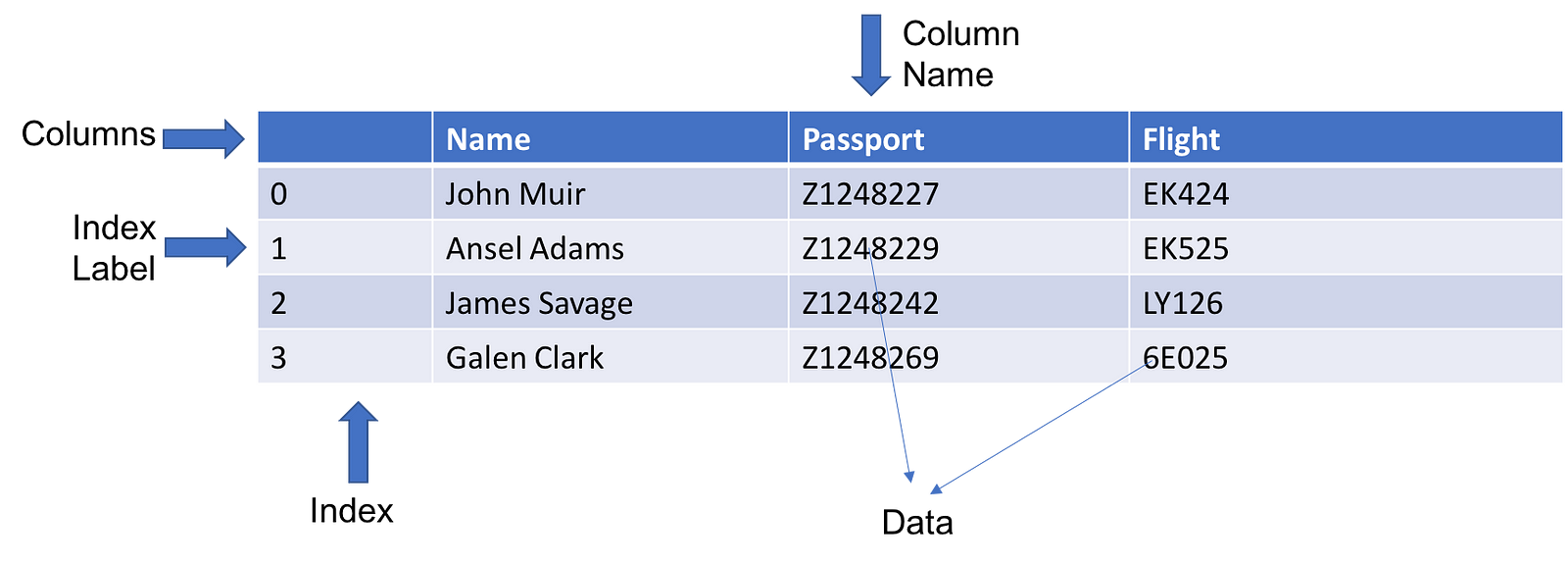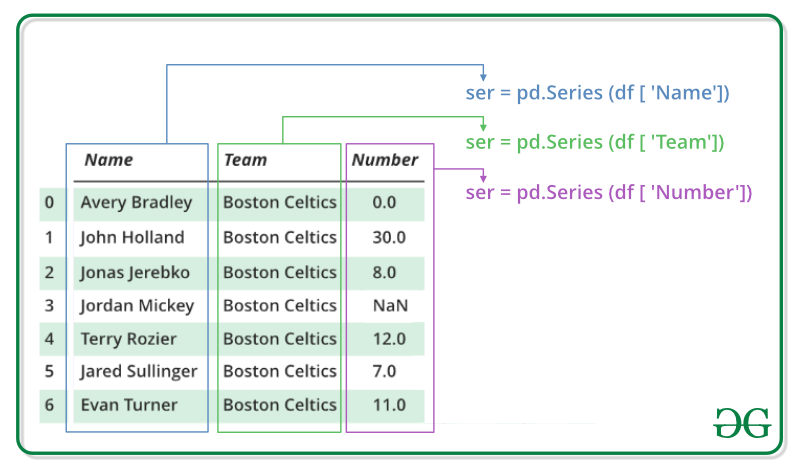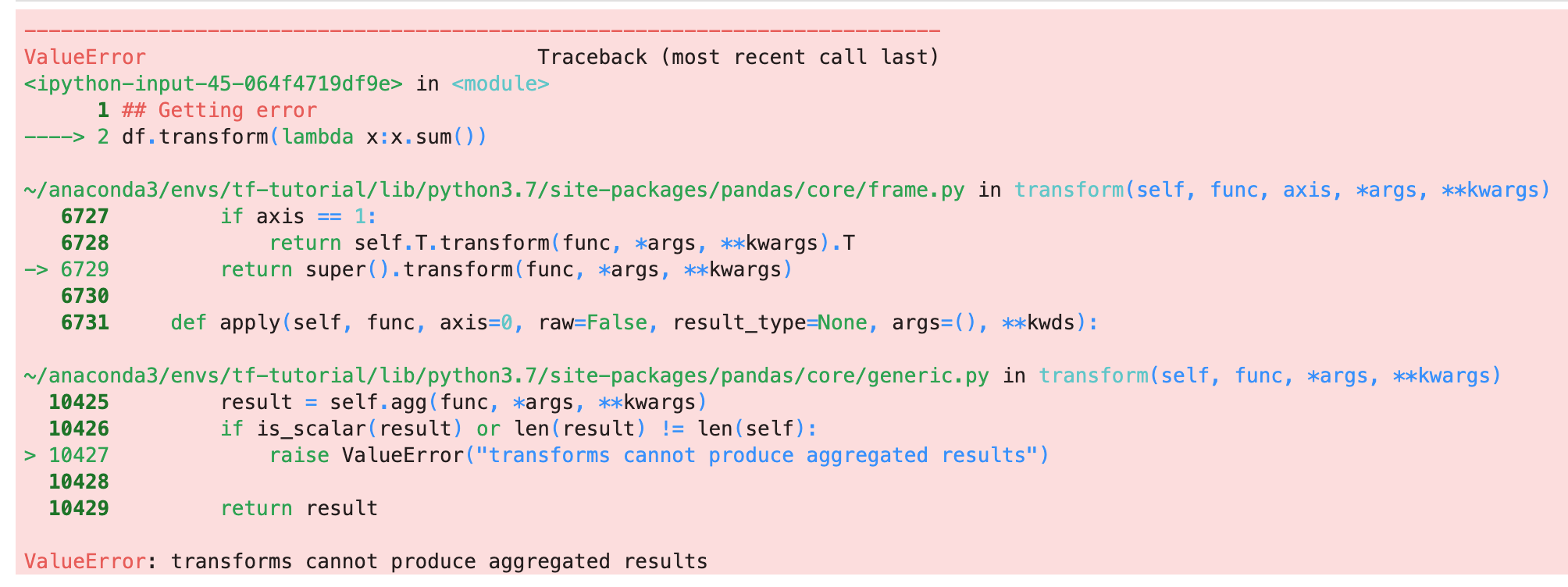38 pandas series get labels
Pandas Series Attributes - AlphaCodingSkills - Java Series attributes reflect information that is intrinsic to the series. Accessing a series through its attributes allows us to get the intrinsic properties of the series. Most commonly used attributes are mentioned below: Function. Description. Series.dtype. Return the dtype object of the underlying data. Series.empty. pandas.Series.loc — pandas 0.25.0.dev0+752.g49f33f0d documentation Access a group of rows and columns by label (s) or a boolean array. .loc [] is primarily label based, but may also be used with a boolean array. Allowed inputs are: A single label, e.g. 5 or 'a', (note that 5 is interpreted as a label of the index, and never as an integer position along the index). A list or array of labels, e.g. ['a', 'b', 'c'].
Pandas Series - W3Schools Create Labels With the index argument, you can name your own labels. Example Create you own labels: import pandas as pd a = [1, 7, 2] myvar = pd.Series (a, index = ["x", "y", "z"]) print(myvar) Try it Yourself » When you have created labels, you can access an item by referring to the label. Example Return the value of "y": print(myvar ["y"])
Pandas series get labels
Pandas Series: How to Use Series In Python - AppDividend The Series is the one-dimensional labeled array capable of holding any data type. Series is the one-dimensional labeled array capable of carrying data of any data type like integer, string, float, python objects, etc. Pandas Series Example. The axis labels are collectively called index. Pandas Series: idxmax() function - w3resource Get the row label of the maximum value in Pandas series . The idxmax() function is used to get the row label of the maximum value. If multiple values equal the maximum, the first row label with that value is returned. Syntax: Series.idxmax(self, axis=0, skipna=True, *args, **kwargs) Parameters: Name Description How to print x-axes labels in pandas.Series.plot()? Having a look at the Pandas plot method (on the DataFrame object), we can see that it returns a matplotlib Axes object. Try something like this: ax = df.groupby ('owner_team').inc_subj.count ().plot.bar (ylim=0) ax.set_xticklabels (df.owner_team) # if they are still present as strings
Pandas series get labels. pandas.Series — pandas 1.4.2 documentation Constructing Series from a 1d ndarray with copy=False. >>> r = np.array( [1, 2]) >>> ser = pd.Series(r, copy=False) >>> ser.iloc[0] = 999 >>> r array ( [999, 2]) >>> ser 0 999 1 2 dtype: int64. Due to input data type the Series has a view on the original data, so the data is changed as well. A Practical Introduction to Pandas Series | by B. Chen - Medium A practical introduction to Pandas Series (Image by Author using canva.com). DataFrame and Series are two core data structures in Pandas.DataFrame is a 2-dimensional labeled data with rows and columns. It is like a spreadsheet or SQL table. Series is a 1-dimensional labeled array. It is sort of like a more powerful version of the Python list.Understanding Series is very important, not only ... pandas.Series — pandas 1.4.2 documentation Invoke function on values of Series. argmax ( [axis, skipna]) Return int position of the largest value in the Series. argmin ( [axis, skipna]) Return int position of the smallest value in the Series. argsort ( [axis, kind, order]) Return the integer indices that would sort the Series values. Convert pandas.DataFrame, Series and list to each other After generating pandas.DataFrame and pandas.Series, you can set and change the row and column names by updating the index and columns attributes.. pandas: Rename columns/index names (labels) of DataFrame; For list containing data and labels (row/column names) Here's how to generate pandas.Series from a list of label and value pairs.. Break it down into a list of labels and a list of values ...
how to Access the elements of a Series in python - pandas Accessing data from series with Labels or index: A Series is like a fixed-size dictionary in that you can get and set values by index label. Retrieve a single element using index label: 1 2 3 4 5 6 7 8 # create a series import pandas as pd import numpy as np data = np.array ( ['a','b','c','d','e','f']) Labeling your axes in pandas and matplotlib Specify axis labels with pandas. When you plot, you get back an ax element. It has a million and one methods, two of which are set_xlabel and set_ylabel. # Draw a graph with pandas and keep what's returned ax = df. plot (kind = 'scatter', x = 'GDP_per_capita', y = 'life_expectancy') # Set the x scale because otherwise it goes into weird negative numbers ax. set_xlim ((0, 70000)) # Set the x ... Pandas: Get label for value in Series Object - Stack Overflow How is it possible to retrieve the labe of a particular value in a pandas Series object: For example: labels = ['a', 'b', 'c', 'd', 'e'] s = Series (arange(5) * 4 , labels) Which produces the Series: a 0 b 4 c 8 d 12 e 16 dtype: int64 How is it possible to get the label of value '12'? Thanks . python ... Python Tryit Editor v1.0 - W3Schools x 1 y 7 z 2 dtype: int64 ... Run Get your own website Result Size: 497 x 414
Modifying a Series in-place | Learning pandas - Second Edition The value at a specific index label can be changed in place by assignment: Rows can be removed from a Series by passing their index labels to the del () function. The following demonstrates removal of the row with the index label 'a': To add and remove items out of place, you use pd.concat () to add and remove using a Boolean selection. Convert Pandas Series to a List - Data Science Parichay You can use the tolist () function associated with the pandas series or pass the series to the python built-in list () function. The following is the syntax to use the above functions: # using tolist () ls = s.tolist() # using list () ls = list(s) Here, s is the pandas series you want to convert. How to get the index and values of series in Pandas? A pandas Series holds labeled data, by using these labels we can access series elements and we can do manipulations on our data. However, in some situations, we need to get all labels and values separately. Labels can be called indexes and data present in a series called values. If you want to get labels and values individually. How to Change Column Labels in Pandas DataFrame? - Python In this tutorial, we shall learn how to rename column labels of a Pandas DataFrame, with the help of well illustrated example programs. Syntax The syntax to assign new column names is given below. dataframe.columns = new_columns The new_columns should be an array of length same as that of number of columns in the dataframe.
Pandas Select Rows by Index (Position/Label) To select the rows, the syntax is df.loc [start:stop:step]; where start is the name of the first-row label to take, stop is the name of the last row label to take, and step as the number of indices to advance after each extraction; for example, you can use it to select alternate rows.
How to prefix string to a pandas series labels? - Tutorials Point It will add the given string before the row labels of the series. Example import pandas as pd series = pd.Series (range (1,10,2)) print (series) # add Index_ prefix to the series labels result = series.add_prefix ('Index_') print ("Prefixed Series object with a string: ", result) Explanation
Pandas Get Column Names from DataFrame - Spark by {Examples} You can get the Pandas DataFrame Column Names by using DataFrame.columns.values method and to get it as a list use tolist(). Each column in a Pandas DataFrame has a label/name that specifies what type of value it holds/represents. Getting a column names is useful when you wanted to access all columns by name programmatically or manipulate the ...
Pandas Series: drop() function - w3resource Remove series with specified index labels. The drop() function is used to get series with specified index labels removed. Remove elements of a Series based on specifying the index labels. When using a multi-index, labels on different levels can be removed by specifying the level. Syntax: Series.drop(self, labels=None, axis=0, index=None ...
pandas.Series.loc — pandas 1.4.2 documentation pandas.Series.loc ¶ property Series.loc ¶ Access a group of rows and columns by label (s) or a boolean array. .loc [] is primarily label based, but may also be used with a boolean array. Allowed inputs are: A single label, e.g. 5 or 'a', (note that 5 is interpreted as a label of the index, and never as an integer position along the index).
Python | Pandas Series.get() - GeeksforGeeks Feb 13, 2019 · As we can see in the output, the Series.get () function has returned the value corresponding to the passed index label. Example #2 : Use Series.get () function to get the value for the passed index label in the given series object. import pandas as pd sr = pd.Series ( [11, 21, 8, 18, 65, 84, 32, 10, 5, 24, 32])
Python Pandas Series - Python Examples Pandas Series. Pandas Series is a one-dimensional labeled, homogeneously-typed array. You can create a series with objects of any datatype. Be it integers, floats, strings, any datatype. You can have a mix of these datatypes in a single series. In this tutorial, we will learn about Pandas Series with examples.
7 Reindexing and altering labels — Pandas Doc - GitHub Pages reindex () is the fundamental data alignment method in pandas. It is used to implement nearly all other features relying on label-alignment functionality. To reindex means to conform the data to match a given set of labels along a particular axis. This accomplishes several things: Reorders the existing data to match a new set of labels
How to get the names (titles or labels) of a pandas data ... - MoonBooks Get the row names of a pandas data frame. Let's consider a data frame called df. to get the row names a solution is to do: >>> df.index Get the row names of a pandas data frame (Exemple 1) Let's create a simple data frame:
Labeling Data with Pandas - Medium We will label the data with a '1' if the alcohol % is above or equal to 10% and '0' otherwise: import numpy as np df_wine ['alcohol_class'] = np.where (df_wine ['alcohol']>=10.0, '1', '0') We can now visualize the distribution in binary labels: from collections import Counter plt.title ("Distribution in Alcohol Class Labels")
Python | Pandas Series.keys() - GeeksforGeeks Pandas Series.keys () function is an alias for index. It returns the index labels of the given series object. Syntax: Series.keys () Parameter : None Returns : index Example #1: Use Series.keys () function to return the index labels of the given series object. import pandas as pd sr = pd.Series ( [10, 25, 3, 25, 24, 6])
How to print x-axes labels in pandas.Series.plot()? Having a look at the Pandas plot method (on the DataFrame object), we can see that it returns a matplotlib Axes object. Try something like this: ax = df.groupby ('owner_team').inc_subj.count ().plot.bar (ylim=0) ax.set_xticklabels (df.owner_team) # if they are still present as strings
Pandas Series: idxmax() function - w3resource Get the row label of the maximum value in Pandas series . The idxmax() function is used to get the row label of the maximum value. If multiple values equal the maximum, the first row label with that value is returned. Syntax: Series.idxmax(self, axis=0, skipna=True, *args, **kwargs) Parameters: Name Description
Pandas Series: How to Use Series In Python - AppDividend The Series is the one-dimensional labeled array capable of holding any data type. Series is the one-dimensional labeled array capable of carrying data of any data type like integer, string, float, python objects, etc. Pandas Series Example. The axis labels are collectively called index.














Post a Comment for "38 pandas series get labels"